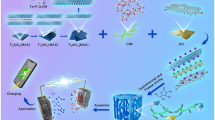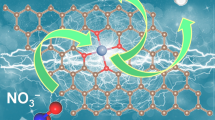Abstract
We developed a novel three-dimensional (3D) graphene oxide foam/Fe3O4 nanocomposite (GOF/Fe3O4) and evaluated its adsorption performance for Cr(IV) removal. The 3D free-standing graphene foam was firstly synthesized on nickel foam and then oxidized and magnetically functionalized with Fe3O4 nanoparticles to form GOF/Fe3O4. The GOF/Fe3O4 exhibited a very large surface area of 574.2 m2/g, a high saturation magnetization of 40.2 emu/g, and a maximum absorption capacity of 258.6 mg/g for Cr(IV) removal, which significantly outperformed the reported 2D graphene-based adsorbents and other conventional adsorbents. The present work may offer a way to prepare a range of 3D magnetic graphene-based adsorbents for application in effective removal of heavy metal ions.











Similar content being viewed by others
References
Bradl HB (2004) Adsorption of heavy metal ions on soils and soils constituents. J Colloid Interf Sci 277:1–18
Hua M, Zhang S, Pan B, Zhang W, Lv L, Zhang Q (2012) Heavy metal removal from water/wastewater by nanosized metal oxides: a review. J Hazard Mater 211:317–331
Kadirvelu K, Thamaraiselvi K, Namasivayam C (2001) Removal of heavy metals from industrial wastewaters by adsorption onto activated carbon prepared from an agricultural solid waste. Bioresour Technol 76:63–65
Erdem E, Karapinar N, Donat R (2004) The removal of heavy metal cations by natural zeolites. J Colloid Interf Sci 280:309–314
Bois L, Bonhommé A, Ribes A, Pais B, Raffin G, Tessier F (2003) Functionalized silica for heavy metal ions adsorption. Colloid Surf A 221:221–230
Hu JS, Zhong LS, Song WG, Wan LJ (2008) Synthesis of hierarchically structured metal oxides and their application in heavy metal ion removal. Adv Mater 20:2977–2982
Stafiej A, Pyrzynska K (2007) Adsorption of heavy metal ions with carbon nanotubes. Sep Purif Technol 58:49–52
Geim AK, Novoselov KS (2007) The rise of graphene. Nat Mater 6:183–191
Kim KS, Zhao Y, Jang H, Lee SY, Kim JM, Kim KS et al (2009) Large-scale pattern growth of graphene films for stretchable transparent electrodes. Nature 457:706–710
Hernandez Y, Nicolosi V, Lotya M, Blighe FM, Sun Z, De S et al (2008) High-yield production of graphene by liquid-phase exfoliation of graphite. Nat Nanotechnol 3:563–568
Ramesha G, Vijaya Kumara A, Muralidhara H, Sampath S (2011) Graphene and graphene oxide as effective adsorbents toward anionic and cationic dyes. J Colloid Interface Sci 361:270–277
Zhang K, Dwivedi V, Chi C, Wu J (2010) Graphene oxide/ferric hydroxide composites for efficient arsenate removal from drinking water. J Hazard Mater 182:162–168
Liu Q, Shi J, Sun J, Wang T, Zeng L, Jiang G (2011) Graphene and graphene oxide sheets supported on silica as versatile and high-performance adsorbents for solid-phase extraction. Angew Chem Int Ed 123:6035–6039
Chandra V, Park J, Chun Y, Lee JW, Hwang IC, Kim KS (2010) Water-dispersible magnetite-reduced graphene oxide composites for arsenic removal. ACS Nano 4:3979–3986
Li C, Shi G (2012) Three-dimensional graphene architectures. Nanoscale 4:5549–5563
Xu Y, Wu Q, Sun Y, Bai H, Shi G (2010) Three-dimensional self-assembly of graphene oxide and DNA into multifunctional hydrogels. ACS Nano 4:7358–7362
Paul RK, Ghazinejad M, Penchev M, Lin J, Ozkan M, Ozkan CS (2010) Synthesis of a pillared graphene nanostructure: a counterpart of three-dimensional carbon architectures. Small 6:2309–2313
Niu Z, Chen J, Hng HH, Ma J, Chen X (2012) A leavening strategy to prepare reduced graphene oxide foams. Adv Mater 24:4144–4150
Li W, Gao S, Wu L, Qiu S, Guo Y, Geng X et al (2013) High-density three-dimension graphene macroscopic objects for high-capacity removal of heavy metal ions. Sci Rep 3:2125
Šafařík I, Ptáčková L, Šafaříková M (2001) Large-scale separation of magnetic bioaffinity adsorbents. Biotechnol Lett 23:1953–1956
Sharda T, Rahaman M, Nukaya Y, Soga T, Jimbo T, Umeno M (2001) Structural and optical properties of diamond and nano-diamond films grown by microwave plasma chemical vapor deposition. Diam Relat Mater 10:561–567
Sun J, Zhou S, Hou P, Yang Y, Weng J, Li X et al (2007) Synthesis and characterization of biocompatible Fe3O4 nanoparticles. J Biomed Mater Res A 80:333–341
Yuan S, Zhou Z, Li G (2011) Structural evolution from mesoporous α-Fe2O3 to Fe3O4@ C and γ-Fe2O3 nanospheres and their lithium storage performances. CrystEngComm 13:4709–4713
Stankovich S, Piner RD, Nguyen ST, Ruoff RS (2006) Synthesis and exfoliation of isocyanate-treated graphene oxide nanoplatelets. Carbon 44:3342–3347
Yang X, Zhang X, Ma Y, Huang Y, Wang Y, Chen Y (2009) Superparamagnetic graphene oxide–Fe3O4 nanoparticles hybrid for controlled targeted drug carriers. J Mater Chem 19:2710–2714
Grosvenor A, Kobe B, Biesinger M, McIntyre N (2004) Investigation of multiplet splitting of Fe 2p XPS spectra and bonding in iron compounds. Surf Interface Anal 36:1564–1574
Fujii T, De Groot F, Sawatzky G, Voogt F, Hibma T, Okada K (1999) In situ XPS analysis of various iron oxide films grown by NO2-assisted molecular-beam epitaxy. Phys Rev B 59:3195
Yang D, Velamakanni A, Bozoklu G, Park S, Stoller M, Piner RD et al (2009) Chemical analysis of graphene oxide films after heat and chemical treatments by X-ray photoelectron and micro-Raman spectroscopy. Carbon 47:145–152
Ni ZH, Yu T, Lu YH, Wang YY, Feng YP, Shen ZX (2008) Uniaxial strain on graphene: Raman spectroscopy study and band-gap opening. ACS Nano 2:2301–2305
Kudin KN, Ozbas B, Schniepp HC, Prud’Homme RK, Aksay IA, Car R (2008) Raman spectra of graphite oxide and functionalized graphene sheets. Nano Lett 8:36–41
Brunauer S, Emmett PH, Teller E (1938) Adsorption of gases in multimolecular layers. J Am Chem Soc 60:309–319
Gollavelli G, Chang CC, Ling YC (2013) Facile synthesis of smart magnetic graphene for safe drinking water: heavy metal removal and disinfection control. ACS Sustain Chem Eng 1:462–472
Stankovich S, Dikin DA, Dommett GH, Kohlhaas KM, Zimney EJ, Stach EA et al (2006) Graphene-based composite materials. Nature 442:282–286
Li D, Kaner RB (2008) Graphene-based materials. Nat Nanotechnol 3:101
Barrett EP, Joyner LG, Halenda PP (1951) The determination of pore volume and area distributions in porous substances. I. Computations from nitrogen isotherms. J Am Chem Soc 73:373–380
Dai S, Burleigh M, Ju Y, Gao H, Lin J, Pennycook S et al (2000) Hierarchically imprinted sorbents for the separation of metal ions. J Am Chem Soc 122:992–993
Ponder SM, Darab JG, Mallouk TE (2000) Remediation of Cr(VI) and Pb(II) aqueous solutions using supported, nanoscale zero-valent iron. Environ Sci Technol 34:2564–2569
Langmuir I (1918) The adsorption of gases on plane surfaces of glass, mica and platinum. J Am Chem Soc 40:1361–1403
Freundlich H (1906) Over the adsorption in solution. J Phys Chem 57:292
WooáLee J, BináKim S (2011) Enhanced Cr(VI) removal using iron nanoparticle decorated graphene. Nanoscale 3:3583–3585
Liu M, Zhang H, Zhang X, Deng Y, Liu W, Zhan H (2001) Removal and recovery of chromium(III) from aqueous solutions by a spheroidal cellulose adsorbent. Water Environ Res 73:322–328
Cao CY, Qu J, Yan WS, Zhu JF, Wu ZY, Song WG (2012) Low-Cost Synthesis of flowerlike α-Fe2O3 nanostructures for heavy metal ion removal: adsorption property and mechanism. Langmuir 28:4573–4579
Cao CY, Cui Z-M, Chen CQ, Song WG, Cai W (2010) Ceria hollow nanospheres produced by a template-free microwave-assisted hydrothermal method for heavy metal ion removal and catalysis. J Phys Chem C 114:9865–9870
Cimino G, Passerini A, Toscano G (2000) Removal of toxic cations and Cr(VI) from aqueous solution by hazelnut shell. Water Res 34:2955–2962
Peterson ML, Brown GE, Parks GA, Stein CL (1997) Differential redox and sorption of Cr(III/VI) on natural silicate and oxide minerals: eXAFS and XANES results. Geochim Cosmochim Ac 61:3399–3412
Cao JS, Zhang WX (2006) Stabilization of chromium ore processing residue (COPR) with nanoscale iron particles. J Hazard Mater 132:213–219
Li S, Lu X, Xue Y, Lei J, Zheng T, Wang C (2012) Fabrication of polypyrrole/graphene oxide composite nanosheets and their applications for Cr(VI) removal in aqueous solution. PLoS One 7:43328
Ai Z, Cheng Y, Zhang L, Qiu J (2008) Efficient removal of Cr(VI) from aqueous solution with Fe@ Fe2O3 core–shell nanowires. Environ Sci Technol 42:6955–6960
Afkhami A, Saber-Tehrani M, Bagheri H (2010) Simultaneous removal of heavy-metal ions in wastewater samples using nano-alumina modified with 2,4-dinitrophenylhydrazine. J Hazard Mater 181:836–844
Zhao YG, Shen HY, Pan SD, Hu MQ, Xia QH (2010) Preparation and characterization of amino-functionalized nano-Fe3O4 magnetic polymer adsorbents for removal of chromium (VI) ions. J Mater Sci 45:5291–5301
Lee SM, Kim WG, Laldawngliana C, Tiwari D (2010) Removal behavior of surface modified sand for Cd(II) and Cr(VI) from aqueous solutions. J Chem Eng Data 55:3089–3094
Sharma D, Forster C (1994) A preliminary examination into the adsorption of hexavalent chromium using low-cost adsorbents. Bioresour Technol 47:257–264
Zhong LS, Hu JS, Cao AM, Liu Q, Song WG, Wan LJ (2007) 3D flowerlike ceria micro/nanocomposite structure and its application for water treatment and CO removal. Chem Mater 19:1648–1655
Author information
Authors and Affiliations
Corresponding author
Rights and permissions
About this article
Cite this article
Lei, Y., Chen, F., Luo, Y. et al. Three-dimensional magnetic graphene oxide foam/Fe3O4 nanocomposite as an efficient absorbent for Cr(VI) removal. J Mater Sci 49, 4236–4245 (2014). https://doi.org/10.1007/s10853-014-8118-2
Received:
Accepted:
Published:
Issue Date:
DOI: https://doi.org/10.1007/s10853-014-8118-2




